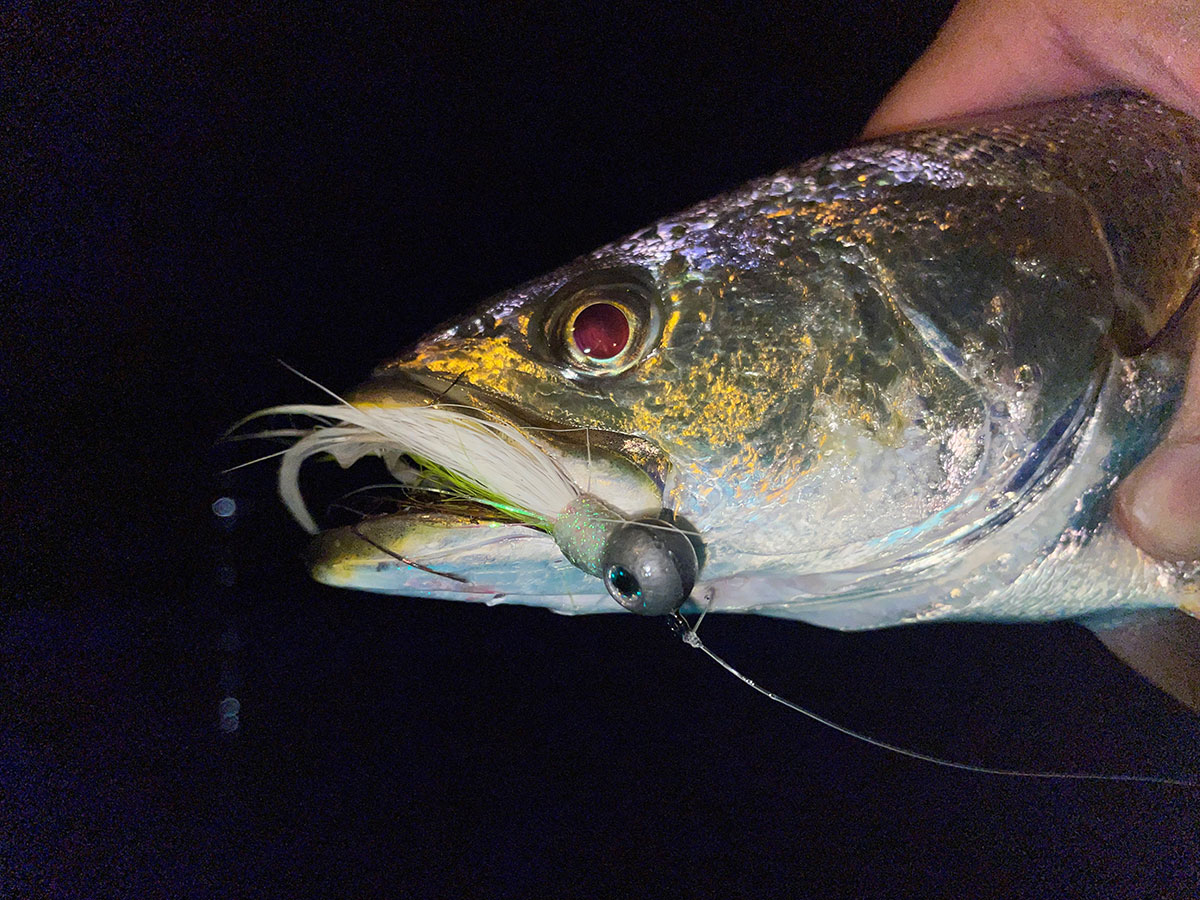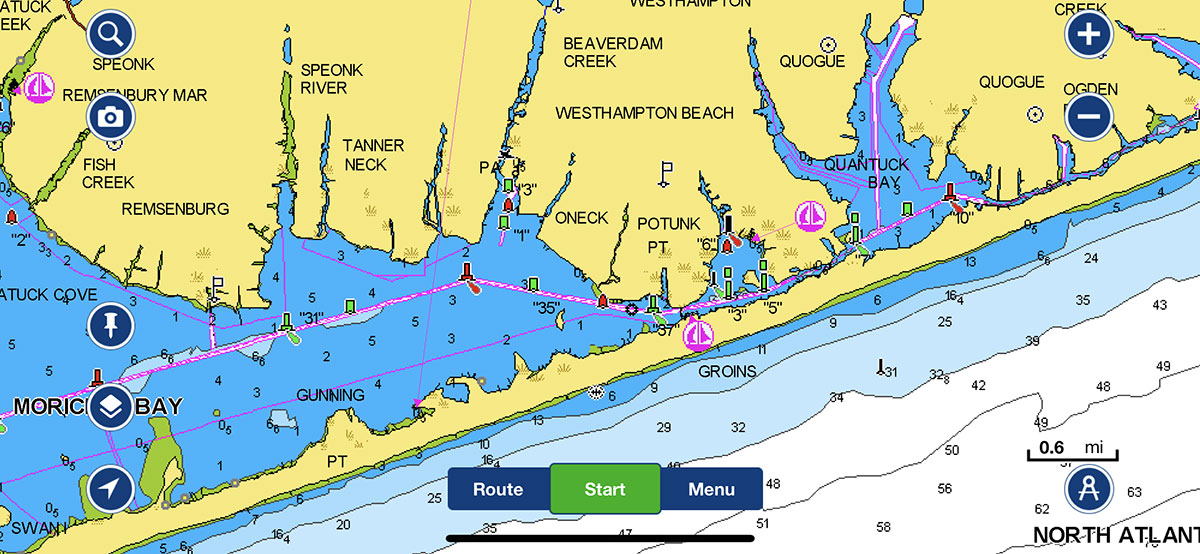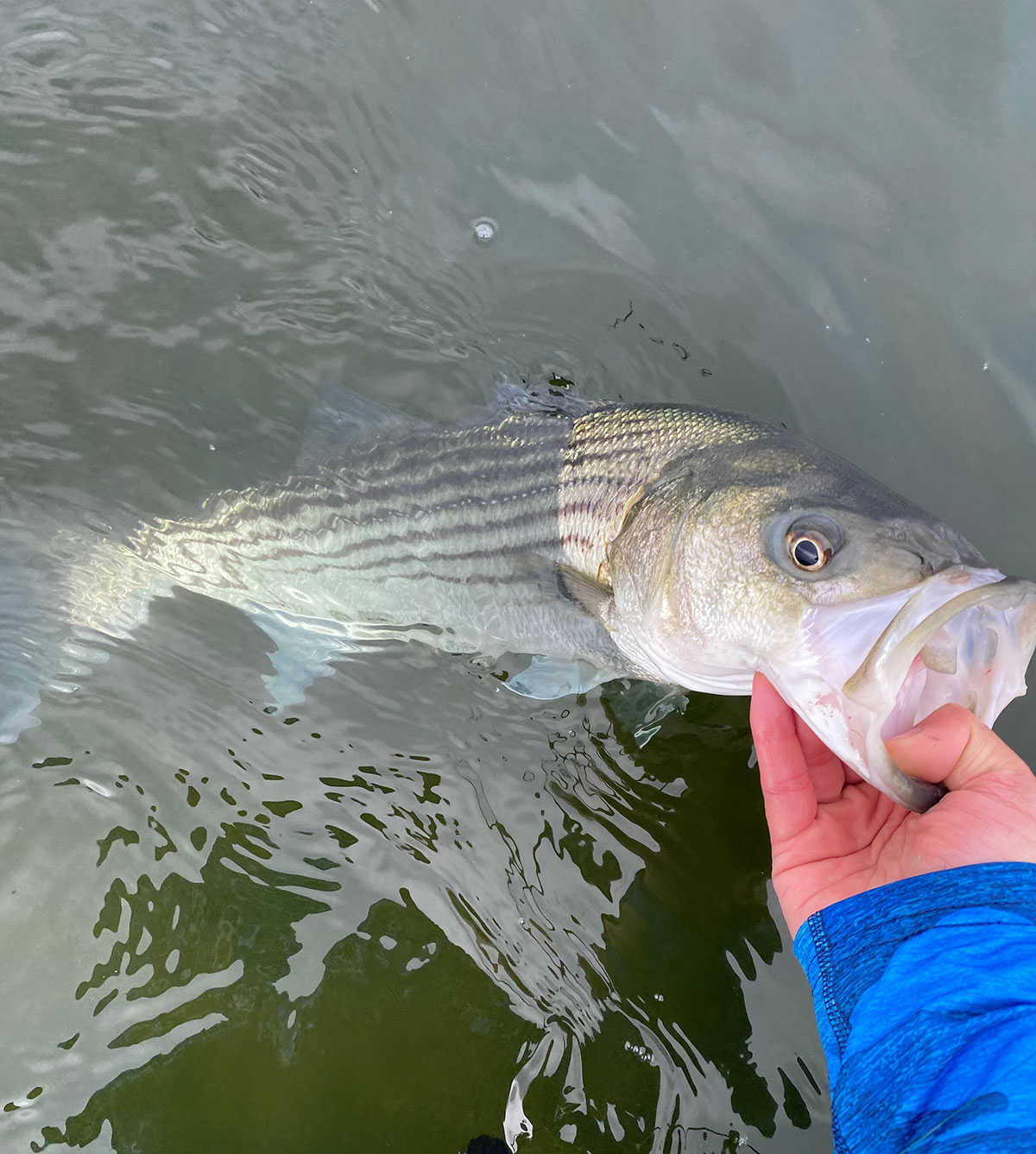
Avoiding popular bridges and focus on nearby deep holes during the early season.
For the past 10 years, by mid-April, it has been time to fish the west end of the Quogue Canal in search of some early weakfish action. Since I’ve kept my Parker inside the Forge River for all these years, the ride east to the west side of the canal to the first West Hampton Bridge takes about 20 minutes from the dock. Although the Quogue Canal is usually the main target, depending on the tide, we normally make a few drifts outside Speonk Point to just off the Remsenburg Yacht Club. Many times, we found it unnecessary to head into Quogue as we found all the action needed off Speonk. The only difference is we have been trading those lovely vampire fangs and yellowfins for hefty, healthy stripers, on average between 12 and 25 pounds. Most often, the action does last throughout the tide, with many slot and oversized bass seeing the hook remover right alongside the boat. We try not to stress or hurt a bass by releasing every one we catch along the broadside of the boat. Many times, as an added bonus, we also release a few weakies estimated in the 3 to 8-pound range. Oddly enough, this spot, for some reason or another, is overlooked as there are rarely more than two or three boats, including ours, fishing this strip of water at any given time. Therefore, if you are an angler looking for an early start and some darn good fishing to boot, then the extreme east end of Moriches Bay may just be your calling.
Remsenburg To The Speonk River
Back in the 80s and 90s, several Nor’easters and hurricanes put a serious hurting along the Fire Island National Seashore, with several areas of the barrier beaches suffering from badly eroding dunes, including a breach east of Moriches Inlet nicknamed Pikes Inlet. It was imperative that Pikes be filled in so that 4X4 vehicles could get to and from Moriches and Shinnecock Inlets. Since the breach was just south of Remsenburg, which consisted of extremely shallow water inside the intercostal channel, the channel between buoys 30 and 31 was dredged out between 15 and 30 feet deep in order to help fill in the Pikes Inlet Breach. The sand was also taken from the ocean side of the breach. Both dredged holes produced miraculous amounts of species with fluke, sea bass, porgies, and triggerfish on the ocean side, while the bay side produced great weakfish, striped bass, bluefish, some fluke, and plenty of panfish during the fall.
What makes this area between buoys 30 and 31 so productive with stripers and weakfish so early in the spring is the 57-degree water temperature that spills out of the Speonk River throughout the year regardless of the season versus the 42-degree water temperature outside the river’s flow parameter. During the early spring, massive schools of egg-laden spearing take advantage of the warm water inside the river and settle close to the marsh banks where the spawning takes place. The trails of these mini morsels set up easy pickings for the bass, which until water temperatures rise up a bit and the bunker and other goodies move into the bays, the stripers remain quite content, sucking down mouthfuls of tasty spearing.

Stripers Inside Quogue Canal Also
With dozens of feeder creeks spilling constantly inside the entire stretch of the Quogue Canal, the water temperature is a remarkable 15 degrees higher than the main bodies of both Shinnecock and Moriches Bay, where, again, these winter tropic locations are where most of the entire list of baitfish make their first stopover of the season. In fact, aside from baitfish, weakfish and striped bass in the canal, there are plenty of thin but long fluke enjoying the warm water and ample food supply. You can tell the fluke are recent arrivals as they are usually so thin that they are nearly translucent. They are almost always a bycatch taken on a jig intended for the weakfish.
As to where to fish in the canal for the weakfish, you will find countless small holes just before and after the first West Hampton Bridge that are in 25 feet of water. Some of the holes hold more weakies than others. Set up your drifts to jig over several on each pass. If you continue east just past the second bridge, the Shinnecock Golf Course is just to your left. Just west of the golf course, tight to the shore, is a deep hole that is 30 feet deep, and there is also good fishing with both weakfish and fluke.
If you want to give stripers a whirl in the canal, your best shot at a few is drifting around the stanchions and abutments of any of the three bridges. Fish these bridges during an outgoing tide, and the current moves swiftly. One-ounce lead head jigs and 7-inch “Albino Shad” Bass Assassins bounced along the bottom is best. Personally, I wouldn’t exhaust too much effort for the stripers in the canal as the drifts are short and can become quite tiring. Instead, apply your energy at Speonk Point, another overlooked hotspot known as Taylor’s Hole.
Sandwiched Between Quogue And Speonk
Taylor’s Hole has long been a favorite spot among local anglers who prefer to catch their weakfish incognito, away from the large crowds. Taylor’s Hole is situated south of buoy 36 on the western end of the Quogue Canal waterway. This area also warms much quicker than most of Moriches Bay, which also attracts a myriad of baitfish, starting with spearing, the early season candy, for both weakfish and striped bass. The hole is approximately 100 yards wide and 30 feet deep and is often overlooked by passing boaters since the hole is not marked on any navigation map, which makes this area a well-kept secret. Since you will need to cross over some shallow water of about 3 feet deep to get to the hole, I strongly suggest hitting this spot at high tide and getting out of the area no later than the first three hours of the outgoing tide. During the months of April and May, we have the “spring tides” to contend with, which means the tides along the South Shore bays become abnormally low. Usually lower than the mean low tide shown on a navigational chart. Despite the spring tides, mid to late April provides the best opportunity for stripers and weakfish as once May rolls into town, so do bluefish and in mass numbers, putting a halt on serious bass and weakies fishing at Taylor’s until next April. Therefore, time is of the essence in this location.
Stand Your Ground
While Quogue Canal and Taylor’s Hole have their times, especially for weakfish, your focus should be between buoys 30 and 31, which is just outside of Seatuck Cove, and the start of Remsenburg to the Remsenburg Yacht Club, which is halfway between buoys 30 and 31. Buoy 30 is right in front of Speonk Point, and buoy 31 sits right outside the Speonk River. The deepest water is located just west of buoy 31, which drops to 30 feet. The channel remains deep towards the yacht club and then shallows off as you head west to buoy 30. You’ll be marking all kinds of fish life along the bottom as you pass buoy 30 and travel east toward buoy 31. This whole stretch of dredged-out water can be productive. However, the most consistent action with stripers has always been by buoy 31 off Speonk Point. Although at times I have seen some anglers anchor in the deeper waters and dole out clam chum to bring stripers to the boat, I believe, however, drifting – particularly when the wind and current coincide – is more beneficial, allowing an angler to cover plenty of ground and different levels of depth which is paramount while the fish are on the move.
When drifting, concentrate your efforts along the channels edges, drop-offs and humps around the deeper areas. After locating the fish, repeat the drift one more time before marking the spot, to be sure it wasn’t just a stray swimming by itself. The area can be marked in three ways; by hitting the man overboard button on your GPS, throwing a marker buoy or taking a land range.

The Tackle Challenge
It’s one thing to slam bass in the 12 to 25-pound range on a 10-pound class spinning outfit, but can you imagine landing one in the 40-pound class? Well, I can attest to what it’s like firsthand. You think I would have learned my lesson after I blew up two or three reels, but truth be told, over the past 10 years, I must have destroyed at least a dozen quality spinning reels. It was always the same thing: blowing out the main and secondary gears. With that said, I would suggest quality spinning or baitcasting reels in the 3/0 to 4/0 with a 7-foot matching rod. Be sure to have at least one spare outfit, just in case.
Ringing The Dinner Bell
Stripers and weakfish basically feed on the same baits in the early going, which include a broad selection of baitfish, crustaceans, and mollusks. Thankfully, however, you don’t have to concern yourself with anything other than bucktails and soft body plastics for a successful outing. On the soft plastic, what seems to be effective are 7-inch Bass Assassins, Z-Man, Zoom Berkley Gulp, and smaller NLBN soft plastic baits. A ½ to 1-ounce unpainted leadhead jig is ideal for getting the plastic to the bottom, where bouncing the jigs along the bottom on a drift speed between a knot to one and a half knots would make for the perfect drift. When it comes to plastics, my first choice is the 7-inch Albino Shad from Bass Assassin attached to a plain triangle jig up to one ounce, depending on the speed of the drift.
| A CURRENT AFFAIR |
| As for the most productive tide, outgoing water has always produced consistently, however there have been many days when both sides of moving water has produced equally well. My main concern is always a drift when the wind and current coincide. An incoming tide and a west wind will give you a steady drift towards the east, while an east wind and an outgoing will drift you west. Perpendicular drifts with winds out of the north or south are fine as long as you set your drifts with the current to drift over the edges of the drop offs. |
As for bucktails, the 1-ounce Spro Power Bucktail is not like any other with its unique shape of the head and placement of the two eyelets for either casting or vertical jigging. The extra strong Gamakatsu hooks and the extra hair make these jigs unique in the way they bounce along the bottom. Add in the bulging eyes, holographic finish, and blazing colors, and you have the perfect elements to keep the rods bending with striped bass. In addition, the Spro Power Bucktail doesn’t fall or hang straight down, as is the case with most bucktails. Its gliding motion through the water acts as if it is swimming along. When jigged along the bottom, its body stays almost parallel, giving the jig a very natural appearance. All the Spro Power Bucktails are made with durable, super sharp, and extra strong Gamakatsu hooks. The white Power Bucktails seem to catch most of the attention, and the Spro 4-inch Eel Double Tail in pearl white or dark shad makes the perfect trailer for the bucktails.
I hope you get the chance to get out to this area this month. It’s been a relatively warm winter so the bass and weakfish should be waiting for you here this spring. Remember, one weakfish no less than 16 inches and one striper between 28 and 31 inches is the daily bag limit. However, catch and release is contagious so I hope you will practice self-restraint for a fish happy tomorrow.



